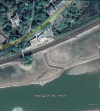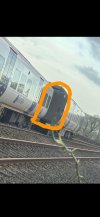I don't think the image below
(from
https://twitter.com/Phil_M_Barrett/status/1771612415039308063/photo/1 )
has been shared before. One of the extra pipes for pumping flood water out to sea, and added in recent years, is visible at the rhs of the image.
It's unclear where the missing ballast went! It isn't visible in the only image I've seen of the Seldom Seen outfall, second image below, from BBC. This outfall was the course of the River Winster before the river was diverted further east (as shown in old OS maps). Seldom Seen drains the enclosed area inland of the embankment, although it doesn't do a good job.
Seldom Seen, by the way, was a rock offshore (marked on old OS 25in maps) which was visible at low tide. It's no longer marked on OS maps
Every fortnight we get a spring tide when the sun, moon and earth are in a line. The tidal range changes at each spring tide and we get the biggest range at solstices and equinoxes. Equinox was last Thursday, the 21st, when day and night were both 12 hours.
So at a spring, the high water and low water are higher and lower than 'normal'
OS maps (and Admiralty charts) define foreshore as between and average spring tides, known as mean high water springs and mean low water springs (MHWS and MLWS). OS maps show the foreshore but not features covered at MHWS For that you mean an Admiralty chart - but they show little of dry land features.
So the rock offshore Strawberryline mentions is submerged at MLWS so thats why its not on OS maps.
So spring tides have a higher high tide with a level higher than MHWS. They also have a lower low tide than MLWS - the tidal range is higher. But also, as the amount of water to move is greater than a non spring, or even a 'normal' spring tide, the tidal flow is greater.
So the culvert will have been submerged more than usual, and the flow of water upstream before high tide and also downstream after high tide witch also have been greater then a 'normal' spring tide. So maybe causing unusual levels of scouring.
With sea levels near land you also have to consider river output. A river close to a site could cause an elevated sea level. Also an onshore wind could cause the water to 'pile up' against the land. An offshore wild could push water away. So the tidal predictions have to be considered alongside the weather to get the actual sea level. This isnt a minor adjustment, you can get variations of up to 0.5metres. Remember, the River Kent drains some of the highest ground in England and floods Kendal in wet weather.
sorry to have gone on about a minor point. hope helps.
BTW, charts are maps of the sea. In the UK they are surveyed and drawn by part of the navy, the Hydrographic Office, which is why I mentioned 'Admiralty Charts'.





